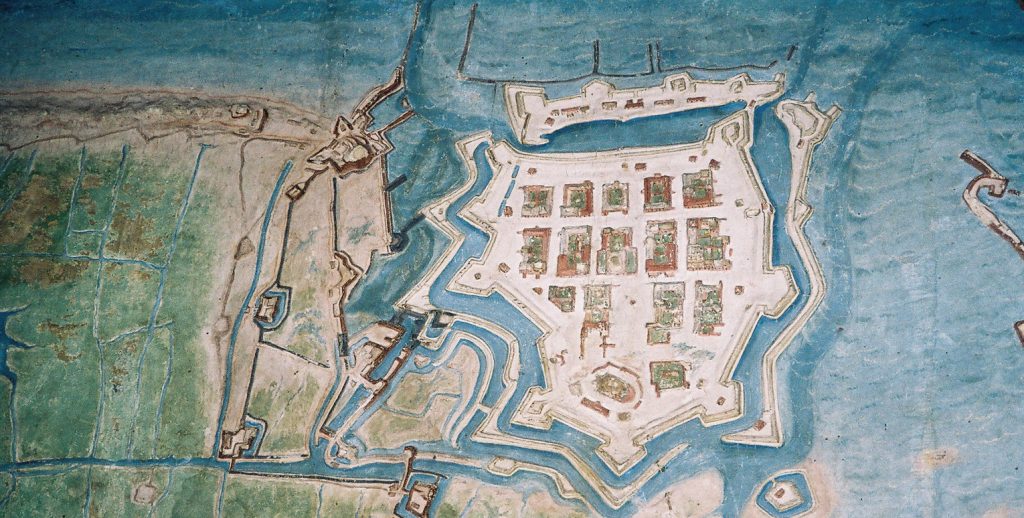
The Exciting News of Ostend (1601-04):
How Florentines Seized the Siege
Online Exhibition
"It seemed to be painted!"
"It seemed to be painted" was Don Giovanni de' Medici's comment, on viewing things from a nearby elevation. What did he see, that his half-brother the Grand Duke, the Tuscan court, and anyone within reach of the news, might have found a compelling object of admiration?
Ostend: one of the great sieges of early modern times, or at least, one of the most controversial. Three year duration; extensive body count for the period; vast expense of resources; inconclusive result despite huge efforts. But what actually happened? Battle reports are a special type of news writing designed to fulfill practical needs while appealing to the reader on numerous levels, and so they are often featured in the handwritten newsletters that are the main sources for the EURONEWS project. Welcome to this virtual exhibit!
In order to test some of our hypotheses about battle writing we have taken a series of soundings in the news culture around the famous military struggles of the Eighty Years War between Spain and the Dutch Republic, sometimes called the Dutch War of Independence.
The eventual Spanish conquest of Ostend in 1604 came at a staggering cost in terms of personnel and materiel (as the documents will show), while providing nearly three full years of excitement and emotion to be tapped by the many writers, scribes, poets, diplomats, and so forth involved in the communication of events. In book 1, chap. 6 of his work Vom Kriege (1832–1834) [On War], Clausewitz claimed that information was the key to successful warfare. Yet while commanders and soldiers required information in order to wage war well, other audiences looked to war for vicarious vendetta, guilty titillation, reinforcement of stereotypes, exercise of prejudice, and even simply as a matter for conversation in the streets, squares and shops.
Our virtual exhibition includes numerous items “borrowed” from their original locations (always with full acknowledgment) and analyzed here as part of the larger EURONEWS project of understanding the production, diffusion and impact of early modern news.
Credits
Euronews Project (Prof. Brendan Dooley, Dr. Davide Boerio, Wouter Kreuze and Sara Mansutti) and The Medici Archive Project (Dr. Maurizio Arfaioli)
Agatino Vacante for photography at Museo di San Marco
How to cite
Dooley Brendan, Maurizio Arfaioli, Sara Mansutti, Wouter Kreuze, "The Exciting News of Ostend" Virtual Exhibition, 2021. https://www.euronewsproject.org/the-exciting-news-of-ostende/ DOI: 10.5281/zenodo.5513749.
Bibliography
The bibliography used for the exhibition is available at this link.
Thanks
We thank all the institutions that have virtually loaned their items to create this exhibition:
Archives de l’État en Belgique, Brussel
Archivio di Stato di Firenze, Florence
Archivio di Stato di Torino, Turin
Bayerische Staatsbibliothek, Munich
Biblioteca Angelica, Rome
Biblioteca Apostolica Vaticana, Rome
Biblioteca nazionale Vittorio Emanuele III, Napoli
Biblioteca universitaria Alessandrina, Rome
Folger Shakespeare Library, Washington
Koninklijke Bibliotheek, The Hague
Museo del Prado, Madrid
Museo di San Marco, Florence
Museum Prinsenhof, Delft
New York Public Library, New York
Österreichische Nationalbibliothek, Vienna
Rijksmuseum, Amsterdam
Royal Collection Trust, Windsor Castle
Stadsarchief Oostende, Ostend
Università degli Studi di Torino, Biblioteca Storica di Ateneo "Arturo Graf", Torino
Universitäts- und Landesbibliothek Düsseldorf, Düsseldorf
Universitätsbibliothek Bern, Bern
Universiteitsbibliotheek Gent, Gent